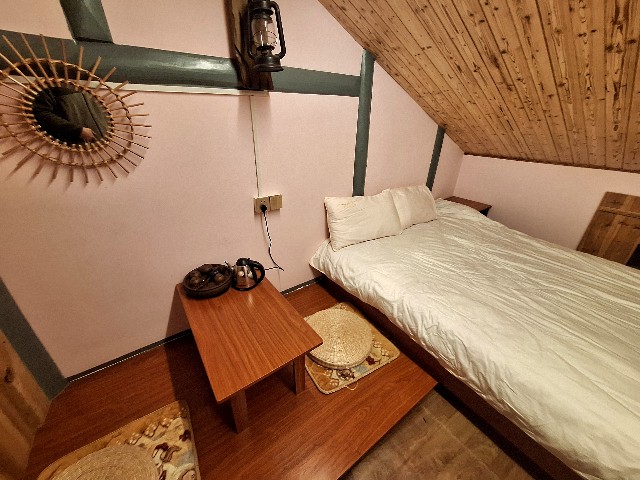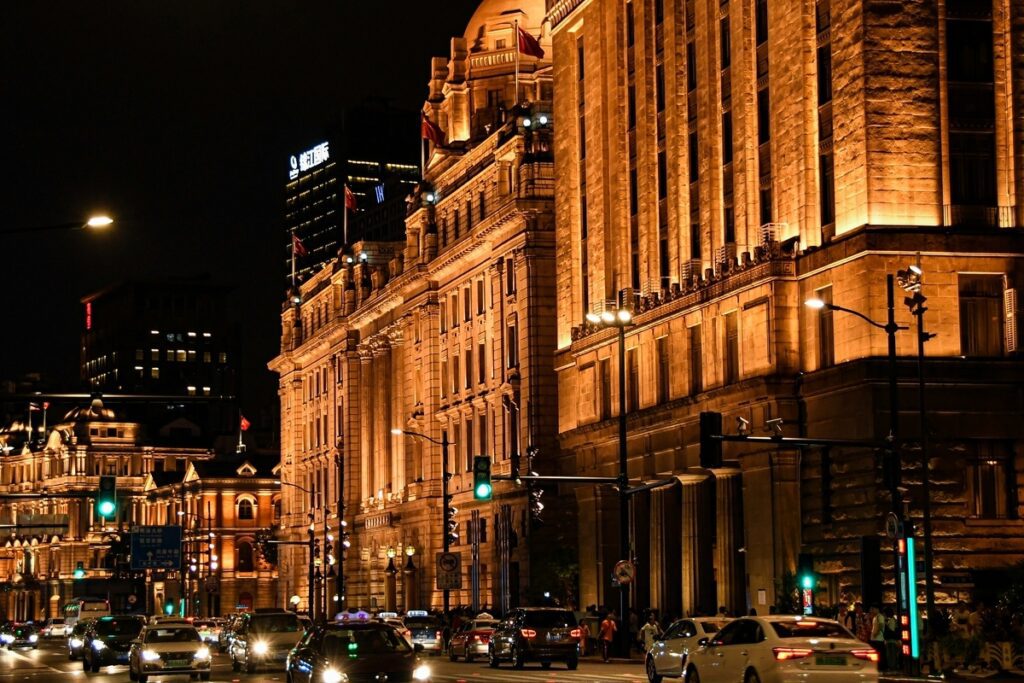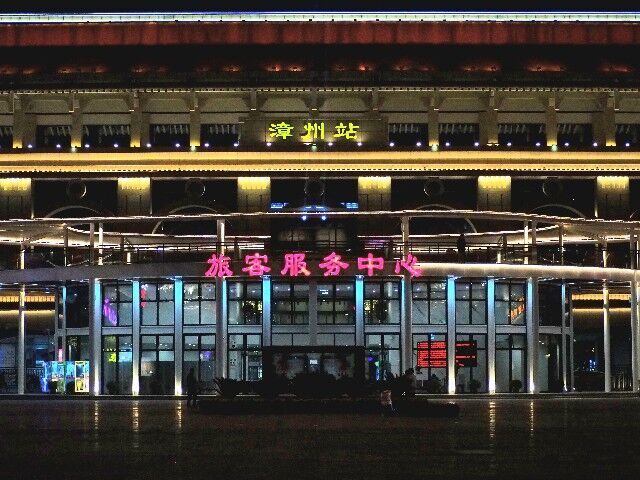In the previous article, I shared my experience booking a stay at Wenchang Lou in the Tianluokeng Tulou cluster through the Chinese booking site “Ctrip.” This time, I’ll report on the actual check-in experience.
Previous article:
Encountering Tulou Floating in the Mist

The famous view from Tianluokeng Tulou Upper Observation Deck
Our bus wound through mountain roads, finally arriving at the Tianluokeng Tulou cluster at dusk. Having already visited other Tulou clusters in Nanjing County earlier that day, I was quite tired, but the sight of the Tulou emerging against the misty mountains instantly reinvigorated me.
The five Tulou buildings, known as “four dishes and one soup” (referring to their arrangement like a traditional Chinese meal setting), stood together more magnificently than any photograph could capture. Particularly striking was Wenchang Lou, with its distinctive oval shape, where I would be staying.

Looking up from the Tianluokeng Tulou Lower Observation Deck, Wenchang Lou is in the foreground
An Unexpected Literacy-Free Check-in

Finally stepping inside Wenchang Lou
Nervously entering Wenchang Lou, I was greeted by a smiling Hakka woman selling cold drinks on the ground floor. When I mentioned my reservation for the guesthouse inside the Tulou, she seemed to want to verify my booking. I showed her the Ctrip reservation screen on my smartphone, but an unexpected situation unfolded.

The kind drink seller who helped me throughout my stay
“Kan bu dong” (I can’t read this), she said, shaking her head. Surprisingly, she couldn’t read Chinese characters. Her son apparently runs the guesthouse, while she primarily speaks the Hakka dialect and isn’t proficient at reading or writing in Standard Chinese (Mandarin).
This was where my limited Chinese skills were put to the test. Using gestures and simple phrases, I managed to communicate that I was “a Japanese visitor with a reservation for today, for a room without a toilet on the second floor or above.” She finally understood.
Like a Secret Hideout! The Journey to the Top Floor Room

Led by the woman, I headed to the upper floors that are normally off-limits to tourists. The aged wooden stairs creaked with each step. As we climbed past the second and third floors, I was treated to a view of the Tulou’s living spaces that regular tourists never get to see.

After navigating the third-floor corridor, we arrived at a different kind of staircase – steep and ladder-like with visibly weathered steps. I was surprised we would need to climb this to reach the fourth floor, but the older woman reassured me with “Mei wenti” (No problem) and beckoned me to follow.

Scrambling up, I reached the fourth floor – the very top of the Tulou. The ceiling sloped downward, with the tiled roof of the building just above. It felt like the secret hideout I had dreamed of as a child.
Surprisingly Comfortable Room and the Legendary “Bucket Toilet”

Opening the door to my room, I was pleasantly surprised by how clean and organized it was – quite a contrast to the building’s aged exterior. Windows on both the inner and outer walls created a refreshing cross-breeze, making for excellent feng shui. The bed was firm but had clean sheets, and there was even a small table provided.

Room with windows on both sides allowing a pleasant breeze to flow through
At the end of the room tour, the elderly woman produced a red bucket with a meaningful expression. This, apparently, was the notorious “bucket toilet” that travelers to the Tulou often mention in their stories. Residents on the upper floors use these buckets at night when they don’t want to trek down to the communal toilets outside, then dispose of the contents in the morning.

The red bucket placed in front of my room was my personal toilet
Fortunately, I was told that the communal toilet near the Tulou entrance was relatively clean and accessible even at night.
Maze-like Corridors and Signs of Everyday Life
After dropping off my luggage, I set out to explore the Tulou. Each floor featured similar circular corridors that felt like a maze. To avoid losing my way back to my room, I used a resident’s red laundry hanging near the staircase as a landmark.

Using residents’ clothes as landmarks to avoid getting lost
The defining feature of Wenchang Lou is its oval shape. While circular and square Tulou are more common, oval ones are quite rare. Looking down at the courtyard from the third-floor corridor felt like viewing a stage from theater balcony seats.

Living in a Living Museum
In the courtyard, residents went about their daily lives. Women chatted around the communal well and water taps. At sinks allocated to each household, people prepared dinner and did laundry, filling the space with the sounds of everyday activity.

The ground floor houses each family’s kitchen and bathroom, with some spaces converted into tea shops and souvenir stores for tourists. It’s truly a scene worthy of being called a “vertical village.” Residents apparently spend most of their day on the ground floor, only using the upper floors for sleeping – a lifestyle rhythm that has continued for generations.
Walking through the corridors, I passed residents hanging laundry or returning from farming work. They cheerfully greeted me, a tourist, with “Chi fan le ma?” (Have you eaten?). This is a common greeting in China, but exchanged in this special Tulou environment, it carried a unique warmth.
What Do You Think?

I’ll continue reporting on my experience at Wenchang Lou guesthouse
In the next article, I’ll share how I spent the evening and the rest of my experience until the following morning. Was I able to spend a comfortable night without resorting to the bucket? And how did my interactions with the residents deepen? My Tulou living experience continues.
Next article






Pingback: [Planning Your Trip] Staying in a Fujian Tulou: Homestay with a Hakka Family in the Tianluokeng Tulou Cluster (Part 1) - Kosupa Travel
Pingback: [Exploring Fujian Tulou] Touring the Five Tulou of Tianluokeng Cluster – Staying Experience (Part 3) - Kosupa Travel
Pingback: How to Get to Fujian Tulou: Are Buses and Taxis a Waste of Time? My On-the-Ground Travel Report - Kosupa Travel